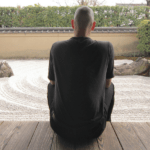
On Pain, Awareness, Self-Regulation, and What People Want in Yoga
September 21, 2017
Sudden Harvest: An Elegy for Michael Stone
September 24, 2017There often comes a moment when I’m presenting on the tangled history of the modern yoga movement to a yoga traing group where the discomfort of the room makes me question what I’m doing.
Is it really important to look into the shadows of modern yoga gurus, and their first generation of students? Aren’t they all gone? Hasn’t their time passed? Haven’t Instagram stars made them invisible? Who really cares anymore?
To me, these questions amount to suggesting we shouldn’t be interested in intergenerational patterns. Which might be like saying we’re not really interested in karma.
But the fact is that very single beautiful and ugly flower of the global yoga explosion – mindful movement, therapeutic insight, artistic brilliance; commodification, performativity, and charismatic narcissism – has a series of tangled roots.
The devotees of yoga gurus have in many places seeded vibrant and positive movement. At the same time, many of them tolerated, covered up or sublimated difficult truths — whether it was about their guru’s abusive behaviour, their conflicted intentions, their ignorance of biomechanics or basic psychology, or the thin evidence that they were working within an authentic “paramparā”. None of this is remarkable, except that unlike artists or sports heroes, they teachers were presumed to have spiritual authority and value.
Secrets cloaked in grandiosity convey an embodied anxiety that must be soothed.
I would say that the main soothers include devotional projection, transference, fixations on detail, and physical over-efforting.
These unconscious efforts contribute to a blend of somatic and relational dogmas.
Somatic dogma (SD) would be: “this series of positions (alignment cues, breath timings) is how you should perform and appear in your body in order to progress or have value”.
Relational dogma (RD) would be: “this is how you should orient yourself towards me/tradition/God”.
Both dogmas can interrupt self-inquiry and freedom. Both are implicated in physical, emotional, and moral injury.
I believe that we’ve done a lot to investigate both separately, but not in relation to each other. What I believe we have to think about is how looking at one often makes the other invisible, or how the felt absence of one seems to cancel out the presence of the other. There’s a lot of teachers who reject the RD they grew up with; they might have even reversed it. This makes their SD invisible, or seemingly beneficent.
The straightness of a posture may have lost its punitive framework, but what resonance does it leave in the tissues?
Both SD and RD are defences. If you know or even half-know that your guru is hitting, injuring, stealing from or molesting people, these dogmas are efficient ways to change the subject, to feel safe again, or to reframe the guru’s behaviour as instrumental to the lesson you believe he’s teaching.
You see or feel something is off (a threat to RD); you work harder to push it down and power through (by invoking SD). What an irony when this happens in yoga, which in so many iterations is expressly concerned with unravelling this exact bodily conditioning.
My first experience of these two defences came from my Catholic boys school. Our church commitments provided a rhythmic silencing and sublimation of interpersonal conflict and hierarchical violence. The organ or the altar bells interrupted our boy-man cycles of dominance and revenge with a heavenly concern, in which glory and dread were all tangled up.
We stood in the straightest postures we could muster (SD), and presented ourselves before nameless authority (RD). We could forget, for a moment, about the priests, teachers, each other, and even ourselves. But it wasn’t truly cathartic.
“Cathartic means you don’t have to go back”, as Anneke Lucas said in one of our interviews. (Sounds synonymous with samadhi.)
I imagine a yoga of no secrets, except the secret of having an internal self, and never really knowing what that means, and having to invent meanings for it you can never adequately share.
A yoga of no coverups, no idealizations, no repetitive stresses, no repressions, no bypasses or sublimations, no photographic fetish, no compensatory efforts or performances.
A yoga of not needing to go back, because you went back thoroughly, and you saw and felt it all clearly.
A yoga that rebuilds its mystery through the utter equality, normalcy, constancy, generosity, forgiveness, and bodily relaxation palpable between its practitioners.
____
Addendum: after reading this piece this morning about the fraud of Sogyal Rinpoche —
Think about it: what happens when the “Buddhism” (or yoga, etc.) you learn from the inner circle/highest echelon of an organization is being presented through the bodies of people who are severely psychologically compromised, whose very survival depends upon Stockholm Syndrome?